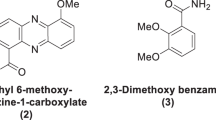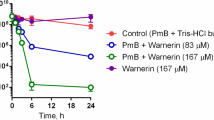Abstract
Nitroxoline (5-nitro-8-quinolinol; NIQ) at subinhibitory concentrations (sub-MIC) decreased the adherence of uropathogenicEscherichia coli to catheter surface and significantly enhanced cell surface hydrophobicity. The surface hydrophobicity increased in the presence of sub-MIC of NIQ and also in an excess of Mg2+. The effect of NIQ on the cell surface was not related to the bacteriostatic effect of this agent. The increase in nitrogen and decrease in phosphate content in the cell surface was found in the presence of NIQ. NIQ did not inhibit the expression of fimbriae.
Similar content being viewed by others
References
Albertsson P.A.:Partition of Cell Particles and Macromolecules, 2nd ed. Wiley Interscience, New York 1971.
Albertsson P.: Partition between polymer phases.J. Chromatogr.159, 111–122 (1978).
Amory D.E., Rouxhet P.G., Dufour J.P.: Flocculence of brewery yeasts and their surface properties: chemical composition, electrostatic charge and hydrophobicity.J. Inst. Brew.94, 79–84 (1988).
Amundsen S.K., Wang C.C., Schwan W.R., Ducan J.L., Schaeffer A.J.: Role ofEscherichia coli adhesins in urethral colonisation of catheterized patients.J. Urol.140, 651–655 (1988).
Archambaud M., Labigne L.: Adhésines des souches deEscherichia coli uropathogènes.Bull. Inst. Pasteur87, 247–279 (1989).
Bourlioux P., Karma D., Amgar A., Perdiz M.: Relation entre les propriétés de chélation de la nitroxoline, l'hydrophobicité de surface et l'inhibition de l'adhérence bactérienne.Pathol. Biol.37, 600–604 (1989).
Brown M.R.W., Williams P.: The influence of environment on envelope properties affecting survival of bacteria in infections.Ann. Rev. Microbiol.39, 527–535 (1985).
Buisson Y.: Les infections nosocomiales: épidemiologie.La Lettre de l'Infectiologue8, 62–63 (1993).
Busscher H.J., Weerkamp A.H.: Specific and nonspecific interactions in bacterial adhesion to solid substrates.FEMS Microbiol. Rev.46, 165–173 (1987).
Carsenti-Etesse H., Durant J., Bernard E., Mandain V., Enteza J., Dellamonica P.: Effect of subinhibitory concentrations of cefamandole and cefuroxime on adherence ofStaphylococcus aureus andStaphylococcus epidermidis to polystyrene culture plates.Eur. J. Clin. Microbiol. Infect. Dis.11, 732–737 (1992).
Daifuku R., Stamm W.E.: Bacterial adherence to bladder uroepithelial cells in catheter-associated urinary tract infection.N. Engl. J. Med.314, 1208–1213 (1986).
Fischer D.: The separation of cells and organelles by partitioning in two polymer aqueous phases.Biochem. J.196, 1–10 (1981).
Gerson D.F., Akil J.: Cell surface energy, contact angles and phase partition.Biochim. Biophys. Acta602, 269–280 (1980).
Gregor R., Sobet J.D.: Bacterial adherence in the pathogenesis of urinary tract infections: a review.Rev. Infect. Dis.9, 470–487 (1987).
Hoštacká A.: Alterations in surface hydrophobicity ofAcinetobacter baumannii induced by meropenem.Folia Microbiol.44, 267–270 (1999).
James A.M.: Charge properties of microbial cell surfaces, pp. 221–262 in N. Mozes, P.S. Handley, H.J. Busscher, P.G. Rouxhet (Eds):Microbial Cell Surface Analysis. Structural and Physicochemical Methods. VCH Publishers, New York 1991.
De Jong Z., Arsicault C., Massip P., Pontonnier F., Bastide R., Plante P., Chabanon G., Pascali P., Tico P.: Infections nosocomiales dans un service d'urologie.Pathol. Biol.39, 561–564 (1991).
Latrache H., Mozes N., Pelletier C., Bourlioux P.: Chemical and physicochemical properties ofEscherichia coli: variations among three strains and influence of culture conditions.Colloids Surfaces B. Biointerfaces2, 47–56 (1994).
Loubeyre C., Desnottes J.F., Moreau N.: Influence of sub-inhibitory concentrations of antibacterials on the surface properties and adhesion ofEcherichia coli.J. Antimicrob. Chemother.31, 37–45 (1993).
Majtánová L., Majtán V.: Postantibioticc effect of ipenem and enoxacin againstS. typhimurium andS. enteridis and the influence on their surface hydrophobicity.Folia Microbiol.43, 104–108 (1998).
Majtánová L., Majtán V.: Postantibiotic effects of gentamicin and netilmicin onSerratia marcescens: effects on hydrophobicity and motility.Folia Microbiol.45, 45–50 (2000).
Marshall K.C., Stout R., Mitchell R.: Mechanism of initial events in the sorption of marine bacteria to surfaces.J. Gen. Microbiol.68, 337–348 (1971).
Mobley H.L.T., Chippendale G.R.: Expression of type 1 fimbriae may be required for persistence ofEscherichia coli in the catheterized urinary tract.J. Clin. Microbiol.25, 2253–2257 (1987).
Mozes N., Léonard A.J., Rouxhet P.G.: On the relation between the elemental surface compositions of yeasts and bacteria and their charge and hydrophobicity.Biochim. Biophys. Acta945, 324–334 (1988).
Nickel J.C., Gristina A.G., Costerton J.W.: Electron microscopic study of an infected Foley catheter.Can. J. Surg.28, 50–52 (1985).
Oliveero L.: Adhesion deEscherichia coli sur sonde. Modulation par effect direct d'une molecule á élimination urinaire: la nitroxoline.PhD Thesis. Université de Paris 1993.
Platt R., Polk B.F., Murdock B., Rosner B.: Mortality associated with nosocomial urinary tract infection.N. Engl. J. Med.307, 637–642 (1982).
Reitherman S.D., Flanagan S., Brandes H.: Electromotive phenomena in partition of erythrocytes in aqueous polymers two phase systems.Biochim. Biophys. Acta297, 193–197 (1973).
Rosenberg M., Doyle R.J.: Microbial cell surface hydrophobicity: history, measurement and significance, pp. 1–37 in R.J. Doyle, M. Rosenberg (Eds.).Microbial Cell Surface Hydrophobicity. American Society for Microbiology, Washington (DC) 1990.
Rouxhet P.G., Genet M.J.: Chemical composition of the microbial cell surface by X-ray photoelectron spectroscopy, pp. 173–220 in N. Mozes, P.S. Handley, H.J. Busscher, P.G. Rouxhet (Eds.):Microbial Cell Surface Analysis. Structural and Physicochemical Methods. VCH Publishers, New York 1991.
Sandberg T., Stenquist K., Svanborg-Eden C.: Effects of subminimal inhibitory concentrations of ampicillin, chloramphenicol and nitrofurantoin on the attachment ofEscherichia coli to human uroepithelial cellsin vitro.Rev. Infect Dis.1, 833–844 (1979).
Sugarman B.: Adherence of bacteria to urinary catheters.Urol. Res.10, 37–40 (1982).
Tawfik A.F., Ramadan M.A., Shibl A.M.: Inhibition of motility and adherence ofProteus mirabilis to uroepithelial cells by subinhibitory concentrations of amikacin.Chemotherapy43, 424–429 (1997).
Väïsänen-Rhen V., Saarela R., Rhen M.: Mutation in clonedEschrichia coli P-fimbriae genes that makes fimbriae-production resistant to suppression by trimethoprim.Microb. Pathogen.4, 369–377 (1988).
Van der Mei H.J., Genet M.J., Weerkamp A.H., Rouxhet P.G., Busscher H.J.: A comparison between the elemental surface compositions and electrokinetic properties of oral streptococci with and without adsorbed salivary constituents.Arch. Oral Biol.11, 889–894 (1989).
Van der Mei H.C., Rosenberg M., Busscher H.J.: Assessment of microbial cell surface hydrophobicity, pp. 263–287 in N. Mozes, P.S. Handley, H.J., Busscher, P.G. Rouxhet (Eds):Microbial Cell Surface Analysis. Structural and Physicochemical Methods. VCH Publishers, New York 1991.
Walter H.: Partition of cells in two-polymer aqueous phases: a surface affinity method for cell separation.Meth. Cell. Separ.1, 307–354 (1977).
Williams P.: Role of the cell envelope in bacterial adaptation to growthin vivo in infections.Biochimie70, 987–1011 (1988).
Author information
Authors and Affiliations
Rights and permissions
About this article
Cite this article
Latrache, H., Bourlioux, P., Karroua, M. et al. Effects of subinhibitory concentrations of nitroxoline on the surface properties ofEscherichia coli . Folia Microbiol 45, 485–490 (2000). https://doi.org/10.1007/BF02818714
Received:
Revised:
Issue Date:
DOI: https://doi.org/10.1007/BF02818714




